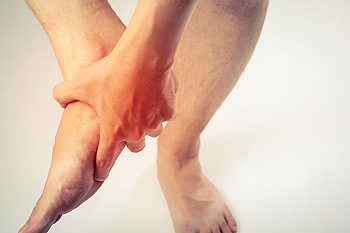Items filtered by date: September 2023
See Your Foot Specialist Regularly If You Work On Your Feet
Extensor Tendonitis

Extensor tendonitis in the feet can occur due to overuse, resulting in pain and discomfort. Extensor tendons play crucial roles in the movement of toes but are vulnerable to injuries. Foot extensor tendonitis typically presents as pain on the top of the foot, often affecting one foot more than the other. It can weaken the tendons, affecting toe movement and push-off ability. Common causes of this condition include wearing tight shoes and running excessively. Diagnosis involves having physical exams and, in some cases, imaging tests such as X-rays, ultrasounds, or an MRI. Treatment includes rest, stretching, and strengthening exercises. Steroid injections may be necessary for severe cases, with surgery reserved for rare instances. Recovery times can vary. Proper care and prevention can effectively manage extensor tendonitis, allowing a return to regular activities. If you think you may have this affliction, it is suggested that you make an appointment with a podiatrist for a proper diagnosis and treatment.
Toe pain can disrupt your daily activities. If you have any concerns, contact one of our podiatrists of Florida. Our doctors can provide the care you need to keep you pain-free and on your feet.
What Causes Toe Pain?
Most severe toe pain is caused due to a sports injury, trauma from dropping something heavy on the toe, or bumping into something rigid. Other problems can develop over time for various reasons.
Toe pain can be caused by one or more ailments. The most common include:
- Trauma
- Sports injury
- Wearing shoes that are too tight
- Arthritis
- Gout
- Corns and calluses
- Hammertoe
- Bunions
- Blisters
- Ingrown toenails
- Sprains
- Fractures (broken bones)
- Dislocations
When to See a Podiatrist
- Severe pain
- Persistent pain that lasts more than a week
- Signs of infection
- Continued swelling
- Pain that prevents walking
Diagnosis
In many cases the cause of toe pain is obvious, but in others, a podiatrist may want to use more advanced methods to determine the problem. These can range from simple visual inspections and sensation tests to X-rays and MRI scans. Prior medical history, family medical history, and any recent physical traumatic events will all be taken into consideration for a proper diagnosis.
Treatment
Treatments for toe pain and injuries vary and may include shoe inserts, padding, taping, medicines, injections, and in some cases, surgery. If you believe that you have broken a toe, please see a podiatrist as soon as possible.
If you have any questions please feel free to contact our offices located in North Miami, and Pembroke Pines, FL . We offer the newest diagnostic tools and technology to treat your foot and ankle needs.
Heel Pain Caused by Bursitis

Heel pain can be debilitating, and one common cause is bursitis. This condition occurs when the bursa, a small fluid-filled sac that cushions and lubricates the joints, becomes inflamed. In the case of heel bursitis, the bursa located at the back of the heel becomes irritated and swollen. The bursa is typically aggravated by activities that put pressure on the affected area, such as walking or wearing tight shoes. Inflammation can also be caused by repetitive overuse or direct trauma to the heel. Diagnosis usually involves a physical examination, and sometimes imaging tests like X-rays or ultrasound are used to rule out other conditions. Treatment options range from rest and ice to reduce inflammation, to physical therapy and orthotic shoe inserts for support. In some cases, a podiatrist may recommend corticosteroid injections to alleviate pain and inflammation. If you're experiencing persistent heel pain, it is suggested that you consult a podiatrist for a proper diagnosis and personalized treatment plan. With the right care, heel bursitis can be managed effectively, allowing you to get back on your feet pain-free.
Many people suffer from bouts of heel pain. For more information, contact one of our podiatrists of Florida. Our doctors can provide the care you need to keep you pain-free and on your feet.
Causes of Heel Pain
Heel pain is often associated with plantar fasciitis. The plantar fascia is a band of tissues that extends along the bottom of the foot. A rip or tear in this ligament can cause inflammation of the tissue.
Achilles tendonitis is another cause of heel pain. Inflammation of the Achilles tendon will cause pain from fractures and muscle tearing. Lack of flexibility is also another symptom.
Heel spurs are another cause of pain. When the tissues of the plantar fascia undergo a great deal of stress, it can lead to ligament separation from the heel bone, causing heel spurs.
Why Might Heel Pain Occur?
- Wearing ill-fitting shoes
- Wearing non-supportive shoes
- Weight change
- Excessive running
Treatments
Heel pain should be treated as soon as possible for immediate results. Keeping your feet in a stress-free environment will help. If you suffer from Achilles tendonitis or plantar fasciitis, applying ice will reduce the swelling. Stretching before an exercise like running will help the muscles. Using all these tips will help make heel pain a condition of the past.
If you have any questions please contact our offices located in North Miami, and Pembroke Pines, FL . We offer the newest diagnostic and treatment technologies for all your foot and ankle needs.
How to Choose the Right Running Shoe

Selecting the right running shoe is crucial for a comfortable and injury-free running experience. This can begin by determining your foot type, which can consist of overpronator, supinator, or neutral. Overpronators need shoes with extra stability, while supinators benefit from cushioning and flexibility. Neutral runners require a balance between both. This is followed by considering your running terrain. Trail runners can choose shoes with durable outsoles and adequate grip, while road runners can go for lighter options with more cushioning. Pay attention to shoe size, ensuring ample room for toe splay, while preventing excessive movement. It is beneficial to try shoes on in the afternoon when your feet are at their largest. The fit can be tested by running or jogging in the store, if possible. Additionally, consider your running goals and any specific needs you have, such as arch support or wide widths. If you would like more information about the various types of running shoes and which one is best for you, it is suggested that you confer with a podiatrist.
If you are a runner, wearing the right running shoe is essential. For more information, contact one of our podiatrists from Florida. Our doctors can provide the care you need to keep you pain-free and on your feet.
Choosing the Right Running Shoe for Your Foot Type
To increase performance and avoid the risk of injury, it is important to choose the right running shoe based on your foot type. The general design of running shoes revolves around pronation, which is how the ankle rolls from outside to inside when the foot strikes the ground.
- Neutral runners are able to choose from a wide variety of shoes, including minimalist shoes or even going barefoot.
- Runners who overpronate, or experience an over-abundance of ankle rolling, should choose shoes that provide extra motion control and stability.
- Runners who underpronate, or supinate, have feet that have high arches and lack flexibility, preventing shock absorption. They require shoes with more flexibility and cushion.
If you have any questions please feel free to contact our offices located in North Miami, and Pembroke Pines, FL . We offer the newest diagnostic and treatment technologies for all your foot and ankle needs.
Reasons to See a Podiatrist

Foot and ankle issues, from various causes like chronic conditions or ill-fitting shoes, can interfere with daily life. Consulting a podiatrist is important for conditions like joint pain, often accompanied by swelling, redness, stiffness, or tenderness, which could be due to arthritis. Diabetes increases the risk of foot problems, from dry skin to severe complications like neuropathy, and regular podiatrist foot exams significantly lower amputation risks. Persistent heel pain caused by things like heel spurs or inflamed tendons requires a podiatrist's diagnosis and tailored treatment. Stubborn ingrown toenails, a common issue, may lead to infection and a podiatrist can provide timely treatment, including nail removal in chronic cases. Suspected foot or ankle injuries, such as sprains or strains, demand prompt diagnosis and treatment. Corns and calluses, if left untreated, can be painful and a podiatrist can safely remove them and offer prevention advice. Runners prone to issues like shin splints benefit from a podiatrist's assessment and recommendations for suitable athletic footwear. Painful bunions worsen without treatment, and a podiatrist can suggest measures like padding, taping, or orthotics. Suspected athlete's foot, a fungal infection causing itchiness and scaliness between the toes, requires professional care if over-the-counter treatments do not work. If you have any sort of foot or ankle problems, it is suggested that you make an appointment with a podiatrist who can address these concerns, and offer diagnosis, treatment, and preventative guidance to enhance mobility and well-being.
If you are experiencing pain in the feet or ankles, don’t join the stubborn majority refusing treatment. Feel free to contact one of our podiatrists from Florida. Our doctors can provide the care you need to keep you pain-free and on your feet.
What Is a Podiatrist?
Someone would seek the care of a podiatrist if they have suffered a foot injury or have common foot ailments such as heal spurs, bunions, arch problems, deformities, ingrown toenails, corns, foot and ankle problems, etc.
Podiatric Treatment
A podiatrist will treat the problematic areas of the feet, ankle or lower leg by prescribing the following:
- Physical therapy
- Drugs
- Orthotic inserts or soles
- Surgery on lower extremity fractures
A common podiatric procedure a podiatrist will use is a scanner or force plate which will allow the podiatrist to know the designs of orthotics. Patients are then told to follow a series of tasks to complete the treatment. The computer will scan the foot a see which areas show weight distribution and pressure points. The podiatrist will read the analysis and then determine which treatment plans are available.
If you have any questions please feel free to contact our offices located in North Miami, and Pembroke Pines, FL . We offer the newest diagnostic and treatment technologies for all your foot and ankle needs.

